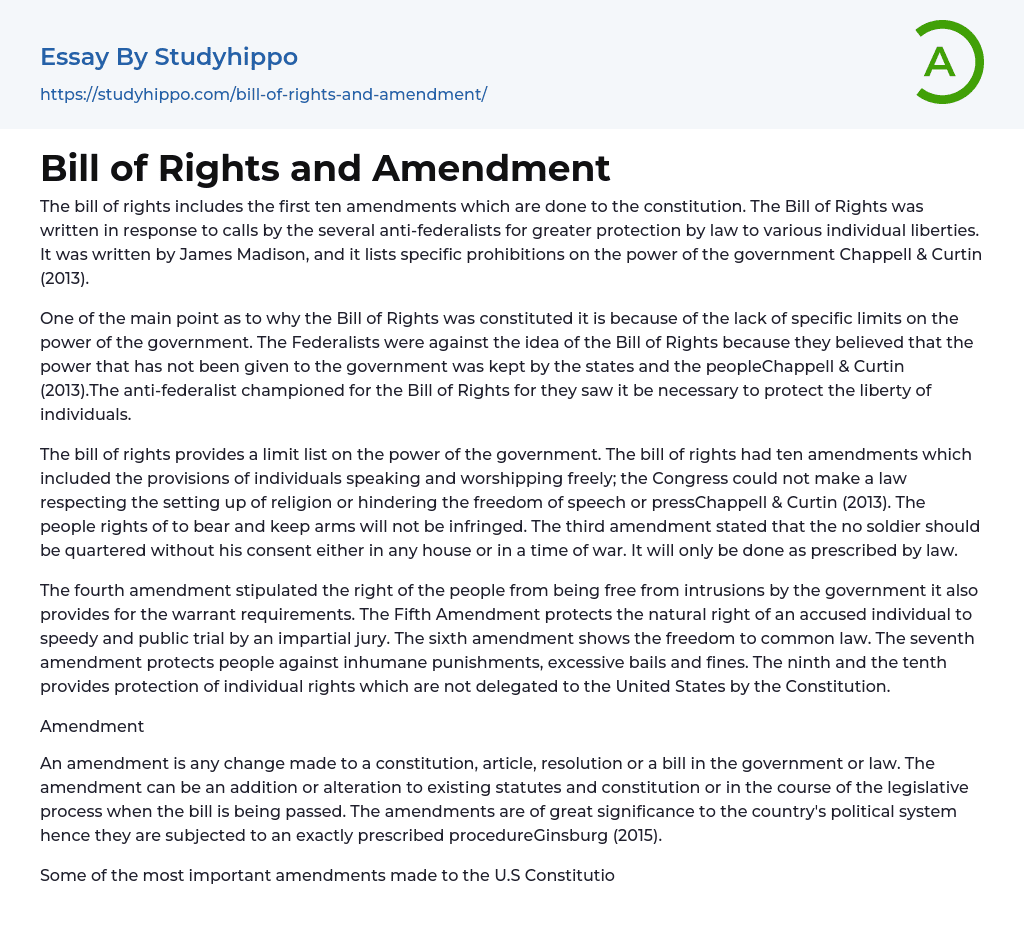The Bill of Rights was established in response to the apprehensions of the anti-federalists, who sought enhanced legal safeguards for diverse individual liberties. It encompasses the initial ten amendments to the Constitution.
The text discusses the Bill of Rights, which was written by James Madison and emphasizes specific limitations on government power (Chappell & Curtin, 2013). Its main purpose was to address the lack of explicit constraints on government authority. While Federalists opposed it and argued that powers not given to the government were retained by states and individuals (Chappell & Curtin, 2013), Anti-Federalists supported it as a way to protect individual liberty. The Bill of Rights consists of ten amendments, including provisions for freedom of speech, religion, and the press. Congress is prohibited from creating laws that establish a particular religion or restrict free speech and press (Chappell & Curt
...in, 2013). Individuals also have the right to bear arms without infringement.
The third amendment prohibits the quartering of soldiers in any house without the owner's consent, both during peacetime and wartime, except as allowed by law. The fourth amendment safeguards individuals' freedom from government intrusions and outlines warrant requirements. The Fifth Amendment guarantees an accused person's right to a speedy and public trial by an impartial jury. The sixth amendment protects the individual's freedom to common law. The seventh amendment defends people against cruel and unusual punishments, excessive bails, and fines.
Amendment
The ninth and tenth amendments safeguard individual rights that are not explicitly granted by the Constitution. An amendment refers to a modification made to a constitution, article, resolution, or bill within the government or legal system. It can involve appending or
altering existing laws and constitutions during the legislative process of passing a bill. Amendments play a crucial role in shaping a country's political system and must adhere to a specific procedure (Ginsburg, 2015). The initial ten amendments of the U.S Constitution, recognized as the Bill of Rights, hold particular significance. Article V of the United States Constitution outlines the process for amending this document.
To summarize, the constitution has undergone 27 amendments. The amendment process mandates approval from two-thirds of Congress members and ratification from three-quarters of the states. Congress members possess the authority to determine whether ratification will take place via popularly elected conventions or state legislatures (Ginsburg, 2015). Conventions were employed solely on one occasion during the repeal of prohibition in the twenty-first amendment.
The electorate in many states must approve the proposed amendments to the U.S Constitution through a popular referendum.
The Bill of Rights vs Amendments
An amendment refers to any addition or alteration made to established statutes and constitution during the legislative process. The bill of rights, on the other hand, encompasses the first ten amendments added to the constitution after its passage. In terms of content, the major distinction between the bill of rights and amendments lies in the fact that the former establishes rules and outlines government limitations (Blau, 2016).
The amendments, which include the Bill of Rights, constitute the entirety of the government's system. They delineate the power of the government and impose limitations to prevent unwarranted interference in people's lives while ensuring freedom of speech and religion (Blau, 2016). Alongside this, the amendments aim to unify and reconcile different facets of governmental authority, differing from
the primary purpose of establishing a government as outlined in the Bill of Rights.
The amendments and the Bill of Rights are both significant in shaping the government system of the United States. The amendments outline various aspects, including the composition of Congress, the powers of different branches of government (such as the president), and other laws (Blau, 2016). In contrast, the Bill of Rights specifically prohibits certain actions for the federal government, such as creating ex-post facto laws. James Madison wrote this bill with support from anti-federalists (Blau, 2016). Unlike amendments that require approval from states, Congress and a popular vote in a referendum, passing the bill does not necessitate a popular vote from voters.
References
- Chappell, L., ; Curtin, J. (2013). Does federalism matter? Evaluating state architecture and family and domestic violence policy in Australia and New Zealand. Publius: The Journal of Federalism, 43(1), 24-43.
- Ginsburg, T., ; Melton, J. (2015).
Does the constitutional amendment rule matter at all? Amendment cultures and the challenges of measuring amendment difficulty. International Journal of Constitutional Law, 13(3), 686-713.
Blau, J. (2016, July). Human Rights: What the United States Might Learn from the Rest of the World and, Yes, from American Sociology.
In Sociological Forum.
- Bill Of Rights essays
- Civil Liberties essays
- First Amendment To The United States Constitution essays
- Fourth Amendment To The United States Constitution essays
- Second amendment essays
- Abraham Lincoln essays
- Andrew Jackson essays
- Barack Obama essays
- Bill Clinton essays
- Donald Trump essays
- Franklin D. Roosevelt essays
- George W. Bush essays
- George Washington essays
- James Madison essays
- John F. Kennedy essays
- Lyndon B. Johnson essays
- Richard Nixon essays
- Theodore Roosevelt essays
- Thomas Jefferson essays
- Vice President essays




